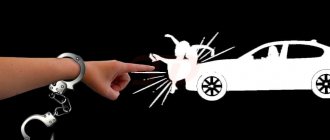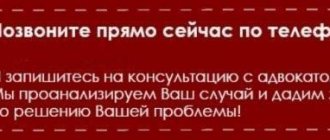When death occurs as a result of the accidental actions of another person, in law it is called negligent causing of death. The experiences of someone through whose fault a person died are understandable, since a tragic coincidence of circumstances is always unexpected and has a shocking effect. But how can we understand that the actions were not intentional and that murder is not hidden behind the version of careless causing of death? In theory and practice, there are many examples when these crimes of different categories border each other so closely that even experienced practicing lawyers find it difficult to draw an unambiguous conclusion about one or another qualification.
Murder is a crime against one’s own kind (Article 105 of the Criminal Code of the Russian Federation)
They can decide to kill for various reasons, but not one of them is justified and cannot exempt from responsibility, since taking a person’s life has always been and will be a cruel crime. A typical murder, qualified under Part 1 of Art. 105 of the Criminal Code of the Russian Federation, usually looks like this:
Example : Dmitriev K., Korobov M., Reztsov P. were drinking alcohol, and as a result of a conflict between Dmitriev K. and Reztsov P., the latter grabbed a kitchen knife and plunged it directly into the left side of Dmitriev K.’s chest. As a result of the damage caused, Dmitriev K. died on the spot.
This is what a “textbook” example of murder looks like, which implies fairly simple actions: he decided to deliver a fatal blow, took the first suitable weapon and did it. Usually under Part 1 of Art. 105 of the Criminal Code of the Russian Federation classifies murders out of hatred, jealousy, while drinking alcohol, etc. A blow that clearly indicates that the perpetrator should have foreseen the lethal outcome corresponds to intentional causing of death, that is, murder as a legal term of criminal law.
How would the law be applied if, in the same example we gave, Reztsov P. stabbed Dmitriev in the side, seriously damaging his liver? Suppose the victim was provided with medical assistance, but despite this, he died in the hospital without regaining consciousness on the fifth day after the injury. Lawyers believe that in this case there is infliction of grievous bodily harm through negligence, resulting in death. The situation, of course, is controversial, but if you establish the intent of the accused - whether he wanted or thought about the possible occurrence of death (Article 105 of the Criminal Code of the Russian Federation), or just wanted to beat him, he did not want the beaten person to die (Part 4 of Article 111 of the Criminal Code of the Russian Federation) .
Murder without prior agreement
It is important to learn to distinguish between deprivation of life with or without prior conspiracy. In the first situation, the criminals had previously agreed on their roles in the situation and probably decided to kill the victim. The second situation does not provide for an agreement - the murder was committed due to unfavorable circumstances.
An agreement can be reached either before committing a murder, or long before the implementation of the assigned task. Both the first and second options cannot in any way influence subsequent qualifications from the point of view of legislation.
Remember! It makes no difference when exactly the participants agreed among themselves. The main task is to confirm the fact of an agreement between them.
If at the time of the commission of the crime another person joined the criminals, he will not be subject to conspiracy.
He hits intentionally, but does not want death (Article 4, 111 of the Criminal Code of the Russian Federation)
In the theory of criminal law, the actions of someone who causes bodily harm, as a result of which the victim died, are almost always classified under Part 4 of Art.
111 of the Criminal Code of the Russian Federation. By default, it is believed that when beating a person without using piercing and cutting objects (knives, rods, axes, etc.), as well as heavy blunt ones (stones, bricks, etc.), the perpetrator could not foresee the result of his actions in form of death. Is it really? Suppose three people beat a fourth with their feet and hands. The beaten person lies on the ground, cannot get up, feeling worse and worse every minute, does not resist, because he does not have the strength to do so. With a high degree of probability, the actions of the criminals will be classified as causing grievous bodily harm. If the victim dies as a result of beating, then this is part 4 of Art. 111 of the Criminal Code of the Russian Federation, since the occurrence of death was not covered by the intent of the beating.
Sometimes experienced practitioners do not agree with this qualification, believing that a severe beating cannot but imply a possible fatal outcome. So, this opinion is especially weighty if:
- the perpetrators significantly exceed their physical characteristics: they are larger in number, they are well physically prepared, much stronger than the victim, who is constitutionally thinner and weaker, and significantly shorter than the attackers;
- the victim has any disease affecting the general physical condition of which the criminals were aware;
- when they beat a bound man, exhausted from torture;
- the deceased was a minor or, conversely, an elderly person;
- if a disabled person or someone with a certain physical disability was beaten, which significantly reduces the ability to fight back against the offenders.
In the listed situations, when there is a clear superiority of the attackers’ power, many theorists are convinced of the crime of “murder,” pointing to the presence of direct or indirect intent to take life, and not just to cause bodily harm.
At the same time, in judicial practice such cases of murder are extremely rare - basically, the actions of criminals are interpreted under Part 4 of Art. 111 of the Criminal Code of the Russian Federation. The motives for making such decisions are associated with the difficulty, and sometimes even the impossibility, of specifying the intent of the beating people - in other words, their intentions are uncertain.
Indeed, even in cases of confession of guilt and a detailed story, the perpetrators cannot say exactly what they expected when inflicting many brutal blows, and what consequences they foresaw. Often during interrogation, the accused say that they beat them and knew that the victim would be hurt and that there might be some kind of injury, which no one specifically expected.
Judicial practice has long been following the path of interpreting all doubts in favor of the convicted, therefore the inability to specify intent in a brutal beating can rarely correspond to murder; it almost always involves causing grievous bodily harm, resulting in death due to negligence.
Article 109 of the Criminal Code of the Russian Federation: causing death by frivolity
This article provides for liability for causing death by thoughtlessness (foresaw the consequences, but thought it would be okay) or negligence (did not foresee, but should have foreseen) - this is a completely careless crime, examples of which may be the following situations:
Examples
- The thief ran out of the store and is hiding from the guards, running away along the city street. A grandmother was walking towards him, whom he pushed away to “clear the way for himself.” Granny hit a cast iron pole hard and received a concussion from which she died;
- The trolleybus smoothly approached the stop, observing all traffic rules. A curious passenger, who suddenly looked out onto the road to see the number of the next trolleybus, was hit in the temple by the mirror of an approaching trolleybus. The victim died on the spot;
- workers were repairing taps in the city sewer and opened the hatch without making sure the surrounding safety. One of the unwary passers-by fell into the sewer, injuring his head, and subsequently died;
- the doctor performed the operation correctly, but the anesthesiologist did not study the patient’s medical record, which indicated the presence of allergic reactions of the patient to lidocaine. As a result of an incorrectly selected medication and anesthesia, the man died.
You can continue to list examples of Art. 109 of the Criminal Code of the Russian Federation, where the main circumstance must be the absence of direct or indirect intent not only for death, but also for any damage and harm in general. It is Article 109 of the Criminal Code of the Russian Federation that causes ambiguity in law enforcement practice in the distinction between murder and serious bodily injury, as a result of which a person died.
Problems of distinguishing careless death from other crimes
The most problematic cases are those in which there is one blow, after which the person falls, hits a ledge, curb, sidewalk, furniture and dies. In such situations, the examination often contains conclusions about the insignificant severity of the injuries caused by the blow, which in themselves could not cause lethality. It is clear that the cause of death is due to injuries sustained during a fall (hitting the sidewalk, ledge, etc.), but surely the person would not have fallen if he had not been hit? It turns out that without the intervention of the one who struck, death would not have occurred.
A typical example was the high-profile case against world champion in martial arts Mirzaev, who was convicted in 2012 under Part 1 of Art. 109 of the Criminal Code of the Russian Federation for striking the victim Agafonov, the latter fell and hit his head on a sewer grate, receiving damage in the form of a serious traumatic brain injury. Agafonov died several hours later.
The opinions of criminal law specialists were equally divided: some of them agreed with the verdict and qualifications, others vehemently criticized it. The arguments of the latter were that a champion of this level should have understood that the force of his blow greatly exceeded the similar action of an ordinary statistical citizen, because after it Agafonov instantly fell backward, without even having time to coordinate his motor functions and soften the blow, for example, by turning his body . Many lawyers believe that in this case Mirzaev foresaw that his blow would cause at least serious harm to health or would cause a sharp fall onto the plane. Theorists see in such a situation not a direct, but an indirect cause-and-effect relationship between the actions of the unfortunate striker and the fatal outcome. Some scientists regard such actions of an athlete trained in the “deadly blow” at a professional level as absolutely deliberate actions that meet the qualifications under Article 105 of the Criminal Code of the Russian Federation.
Another striking example of a controversial qualification is the case against Smirnov, who was initially charged under Part 4 of Art. 111 of the Criminal Code of the Russian Federation. Smirnov was accused that, as a result of a conflict with his wife, he hit her in the face, several times on the body, after which he picked her up and threw her forcefully against the wall, against which she hit and died the next day. The examination established serious bodily injuries to internal organs, which resulted in death. It is interesting that the appellate court expressed its opinion that Smirnov had no intent to cause grievous harm and reclassified his actions under Art. 109 of the Criminal Code of the Russian Federation. Subsequently, the Supreme Court overturned the previous decision, motivating the presence of this intent by the very nature of the injuries: they were multiple and almost all had a sign of danger to life. As a result, it was concluded that the perpetrator had great force and used it in the knowledge that there would be consequences. As a result, Smirnov was punished under Part 4 of Art. 111 of the Criminal Code of the Russian Federation.
Cost of services
Our specialists are primarily interested in an individual approach to business, and only then in material interests, so it is important for us to familiarize ourselves with the details in order to tell the exact cost in Moscow. You can find approximate prices below. What to do if you are suspected under Article 105, Part 2.
We employ competent specialists with rich knowledge in the field of legislation and practical skills honed over the years, who will find grounds for mitigating a sentence, canceling or reviewing already accomplished court decisions. You can call us or leave a request on the website if you want an attentive and professional lawyer to take on your case.
| Providing defense in criminal cases: | Price |
| Visiting detainees in pre-trial detention centers (places of deprivation of liberty) for the purpose of giving legal advice: | from 20,000 rub. |
| Participation of a defense attorney in a court hearing under Art. 125 Code of Criminal Procedure of the Russian Federation: | from 30,000 rub. |
| Participation of a defense lawyer in a court hearing when choosing a preventive measure, extension of the period of detention: | from 30,000 rub. |
| Protection of the client during the investigation, preliminary investigation before sending the criminal case to court | from 50,000 rub. |
| Defense of the principal in the court of first instance, if the defense attorney participated in the preliminary investigation: | from 30,000 rub. |
| Defense of the client in the court of first instance, if the defense attorney did not participate in the preliminary investigation: | from 50,000 rub. |
| Appealing the verdict, ruling, decision of the court of first instance to the appellate instance: | from 70,000 rub. |
| Appeal and protest of a court verdict, rulings and decisions in the cassation instance: | from 50,000 rub. |
| Protection of the principal in court by way of supervision | from 30,000 rub. |
| Organization of examinations, consultations with the participation of specialists, experts in various fields of activity | from 15,000 rub. |
Restriction criteria
The main signs of distinguishing between murder, causing death by negligence or Part 4 of Art. 111 of the Criminal Code are to establish the intent of the perpetrator:
- if serious bodily injuries are caused intentionally and the consequences in the form of death are not included in the thoughts of the criminal, then in the event of a death his actions correspond to Part 4 of Art. 111 of the Criminal Code of the Russian Federation;
- if the blow is not strong, one-time (sometimes it can be twice, usually no more) and clearly corresponds to slight harm to health (an expert will speak out more precisely), but for some reason the person dies, then the actions of the perpetrator comply with Art. 109 of the Criminal Code of the Russian Federation;
- if blows are applied to vital organs with sufficient force to create a danger to the life of the victim, while the perpetrator is indifferent to the possible consequences, we are talking about murder.
Additional circumstances
Quite often, persons who act as part of a group and have the intent to kill are mistakenly not recognized as co-perpetrators. This happens because during the investigation or trial the consequences caused by the actions of such a person are not fully revealed.
Persons whose actions are characterized by varying degrees of intensity or the use of different instruments of crime can be recognized as co-perpetrators of murder.
The prerequisites for such errors are, as a rule, the investigator or judge ignoring the intent of the guilty person.
In a case where two or more persons are killed by a group by prior conspiracy, the main difficulty in qualifying such a crime is that not all the perpetrators directly participate in the commission of the murder.
In addition, quite often when qualifying a murder committed by a group of persons by prior conspiracy, an error such as excess of the perpetrator arises (Article 36 of the Criminal Code of the Russian Federation). The excess of the perpetrator is the commission of a crime by a person that does not include the intent of other accomplices. In this case, accomplices to the murder are not subject to criminal liability.
The main sign of a murder committed by a group of people is not the time when the objective side of the crime was carried out, that is, the infliction of bodily harm on the victim, but the time when the perpetrators reached an agreement to kill.
When a murder is committed by a group of people without prior agreement, such consent appears among the criminals already during the use of violence against the victim. The absence of collusion may be evidenced by the spontaneous nature of the crime, which is committed during a quarrel or fight.
Quite often, when considering a case, courts mistake the coordination of the actions of criminals for a preliminary conspiracy, without finding out the real state of affairs.
What is the punishment for the death of another person
Of course, the legislator provided the most severe punishment for intentionally causing death:
- when there is a “simple” murder (that is, without additional signs) – up to 15 years in prison ;
- If the death of two or more people is caused, the potential penalty increases to 20 years in prison. The same amount is provided for the murder of a minor, a pregnant woman, a group of persons, etc.
- for serious bodily injury resulting in death due to negligence, the perpetrator can receive up to 15 years in prison - this is the maximum term under Part 4 of Art. 111 of the Criminal Code of the Russian Federation;
- if it is indisputably established that death was caused by negligence, but the upper limit of Article 109 of the Criminal Code of the Russian Federation provides for two years of imprisonment as a punishment , and the courts often impose a suspended sentence .
Features of the crime
Murder is covered by Article 105 of the Criminal Code of the Russian Federation. Group actions are discussed in paragraph “g” of the second part of the article.
In addition, there is a Resolution of the Supreme Court of the Russian Federation, which concerns judicial practice under Article 105 (No. 1 of 01/27/99, currently amended as of 12/03/2009). And yet, it is important to understand the difference between murder by a group of people and complicity.
In particular, the Resolution examines some of the subtleties of complicity in murder. For example, if an organized group acted, then it does not matter who was the instigator, organizer, and so on. All members of the group are recognized as co-performers.
In groups with no hierarchy, criminologists are required to determine the role of each participant. In this case, the organizers, instigators, perpetrators and accomplices must be found (if they really were). Only accomplices can have their sentence commuted; everyone else will, in any case, be charged under Article 105.







